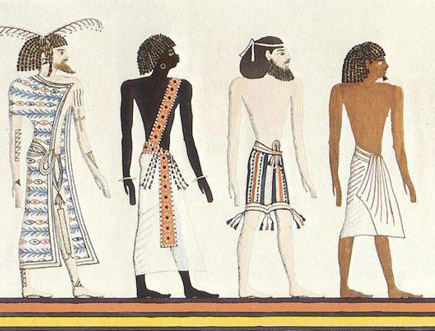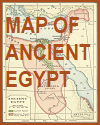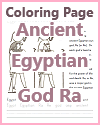| Ancient Egyptian Concept of Cultures |
| www.studenthandouts.com > World History > Ancient Egypt > Ancient Egypt Maps and Pictures |
|
Ancient Egyptian depiction of neighboring peoples including (left to right) a Libyan, a Nubian, an Asiatic (that is, a person from the broad area including modern Turkey and the Levant), and an Egyptian. From the tomb of Pharaoh Seti I.
Ancient Egyptian art was highly stylized and followed specific conventions in portraying people. Here are some key characteristics of how the ancient Egyptians portrayed people in art.  Profile View: Figures were typically depicted in a composite view, with the head and legs shown in profile but the torso facing forward. This composite perspective allowed artists to represent the most recognizable features of each body part.
Profile View: Figures were typically depicted in a composite view, with the head and legs shown in profile but the torso facing forward. This composite perspective allowed artists to represent the most recognizable features of each body part. Hierarchical Proportions: Important individuals or deities were often portrayed on a larger scale than less significant figures in the same scene. This conveyed the social or divine hierarchy within the artwork. Skin Color: Egyptian men were typically depicted with reddish-brown skin, while Egyptian women were shown with lighter yellow skin. This color differentiation was a way to distinguish gender and was based on the premise that men worked outdoors (farming, warfare, etc.) where their skin tanned in the sun, while women worked indoors (cooking, tending to children, etc.). Canon of Proportions: Artists adhered to a set of proportions that governed the size and placement of body parts. For example, the length of the pharaoh's foot was typically used as a standard unit of measure. Stiff and Formal Poses: Figures were often shown with their feet together and arms at their sides. The rigidity of these poses conveyed a sense of order and formality. Frontal Eye: In composite views, the eye was often depicted in a frontal view, with the iris and pupil visible. This convention symbolized the concept that the figure's essence remained focused and unchanging. Symbolism: Many elements of ancient Egyptian art held symbolic meaning. For example, the color green represented fertility, while blue symbolized the Nile River. Hieroglyphs and inscriptions were often incorporated into art to convey information about the figures and scenes. Depiction of Clothing and Symbols: Clothing and accessories were significant in identifying the roles and status of individuals. Pharaohs and deities wore distinctive regalia and symbols. Narrative and Religious Themes: Much of Egyptian art was devoted to conveying religious and narrative themes, with depictions of gods, pharaohs, and scenes from religious texts. Overall, ancient Egyptian art aimed to achieve a balance between idealized representation and conveying the significance and symbolism of the subjects depicted. These conventions were maintained over centuries and created a unique and enduring style that is recognizable as ancient Egyptian art. |
 |
 |
 |
 |
 |
 |
|---|
| Ancient Egypt Books and Films | Ancient Egypt Outlines and PowerPoints |
| Ancient Egypt Maps and Pictures | Ancient Egypt Study Games |
| Ancient Egypt Miscellany | Ancient Egypt Worksheets |
| www.studenthandouts.com > World History > Ancient Egypt > Ancient Egypt Maps and Pictures |






